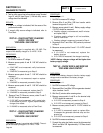
3. Measure across points G and H on the terminal strip.
12VDC should be measured.
a. If 12 VDC is measured, the charger should be
functioning.
b. If 12 VDC is not measured, proceed to Step 4.
4. Remove Wire 0 and Wire 15B from generator terminal
strip locations E and F.
5. Wait five (5) minutes after removing wires.
6. Measure across points E and F on the terminal strip.
12 VDC should be measured.
a. If 12 VDC is measured, proceed to Step 8.
b. If 12 VDC is not measured, proceed to Step 7.
7. Measure across point H and ground lug. 12 VDC should
be measured.
a. If 12 VDC is measured, repair or replace Wire
0 between the generator terminal strip and the
ground lug.
b. If 12 VDC is not measured, proceed to Step 8.
8. Set VOM to measure resistance.
9. Connect the meter test leads across the disconnected
Wire 0 and Wire 15B. Approximately 200 Ohms should
be measured.
a. If 200 Ohms is measured, proceed to Step 11.
b. If zero resistance or CONTINUITY is measured,
connect the meter test leads across BAT- and
XFER on the load center motor.
c. If zero resistance is measured, a short exists.
Replace the load center motor.
d. If 200 Ohms to INFINITY is measured, repair
or replace Wire 15B between the generator and
the load center.
10. Disconnect the J2 connector from the printed circuit board.
11. Measure across point M and pin location J2-8 of the
connector just removed. CONTINUITY should be
measured.
a. If CONTINUITY is not measured, repair or
replace Wire 15B between the J2 connector
and the terminal strip.
b. If CONTINUITY is measured and the pin con-
nection looks good, the internal fuse on the PCB
has failed. Replace the printed circuit board.
TEST 49 – CHECK BATTERY CHARGER
SUPPLY VOLTAGE
“LOAD SHED TRANSFER SWITCH”
DISCUSSION:
The battery charger is supplied with 120 VAC. The
output of the battery charger is 13.4 VDC/2.5A.
PROCEDURE:
Refer to Figure 14.
1. Set VOM to measure AC voltage.
2. Measure across points A and B. 240 VAC should be
measured.
a. If 240 VAC is not measured, verify load source
voltage at ATS.
b. If 240 VAC is measured, proceed to Step 3.
3. Measure across points A and C. 240 VAC should be
measured.
a. If 240 VAC is not measured, repair or replace
Wire T1 between LSS and J3 terminal of load
shed controller.
b. If 240VAC is measured, proceed to Step 4.
4. Measure across points C and D. 120 VAC should be
measured.
a. If 120 VAC is not measured, repair or replace
Wire 00 between J3 terminal and neutral block
(NB).
b. If 120 VAC is measured, proceed to Step 5.
5. Measure across points E and D. 120 VAC should be
measured.
a. If 120 VAC is not measured, replace fuse F3 on
load shed controller.
b. If 120 VAC is measured, proceed to Step 6.
6. Measure across points E and F. 120 VAC should be
measured.
a. If 120 VAC is not measured, replace load shed
controller.
b. If 120 VAC is measured, refer to Flow Chart.
TEST 50 – CHECK BATTERY CHARGER
OUTPUT VOLTAGE
“LOAD SHED TRANSFER SWITCH”
DISCUSSION:
The battery charger is supplied with 120 VAC. The
output of the battery charger is 13.4 VDC/2.5A.
PROCEDURE:
Refer to Figure 14.
1. Set VOM to measure DC voltage.
2. Remove and isolate battery charger black and red leads
from generator terminal strip points G and H.
3. Measure across points G and H. Battery supply voltage
(12 VDC) should be measured.
a. If battery voltage is not measured, wait 5 min-
utes and repeat Step 3. If battery supply voltage
is still not available, refer to Flow Chart.
b. If battery voltage is measured, proceed to Step 4.
Page 92
PART 3
TRANSFER SWITCH
SECTION 3.4
DIAGNOSTIC TESTS


















